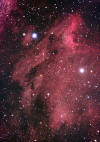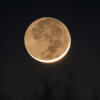Canon EOS 20Da Pictures: Astrophotography
All images and content on this web page Copyright © 2005-2015 Dick Locke. All Rights Reserved. Contact and Image Use Information
The 20Da was the first, and for many years the only DSLR to be produced with astrophotography in mind. This camera is equipped with a special filter that allows the light from deep red H-alpha objects that other, unmodified DSLRs filter out. Most normal DSLRs can be modified by having the stock IR filters replaced. Here's a great link with information about DSLR Camera Modifications for Astrophotography. In April, 2008, I had my 20Da modified by Hap Griffin to get even better H-alpha performance. See also my page on Basic Astrophotography and equipment such as my Takahashi TOA 130 Telescope. In late 2008 I began to use a QHY8 CCD Camera, relegating the 20Da to wide field work. See bottom of page for thoughts on QHY8 CCD vs Canon 20Da DSLR for astrophotography. I am now using a SBIG CCD camera for my serious astrophotography and using the 20Da for widefield work. I was eying a modified Canon 6D as a 20Da replacement as of 8/14.
I switched over to the Nikon D810A for DSLR asto-imaging in 2015 due to my large investment in Nikon lenses and camera bodies for daylight photography. This greatly reduced the amount of equipment I need to haul around on my expeditions ;-)
Below: Visual Index of 20Da DSLR Images
Most photos: Canon EOS 20Da, Takahashi TOA 130 (a 5" APO refractor), Losmandy G-11 mount. This camera has replaced my Nikon D100 for most Astrophotography! Here's my current DSLR Workflow.
- Below: Images from NHAC Neal dark sky observing site, 10/22/2005.
| NHAC Neal Site: 12/28-9/2005 | 01-02-2006 HAS Colombus: The latest and greatest! |

M16
5 minutes, ISO 800, no dark or light frames, no in camera noise reduction, 1200 pixels wide, moderate crop of original. More pix here: M16 Eagle Nebula. This is the object in the famous "Pillars of Creation" shot. | 
M8
2.5 minutes at ISO 400, full frame, else same as left. Do you see the plane? Needs more exposure, but not bad. Main M8 page. |
| Canon D20a and Nikon D100 noise comparison here. | Jerry L's Nikon Canon Astrophotography Page |
Canon D20a and Nikon D100 noise comparison here.
My Current DSLR Workflow here. | 
M33
Stack of 3x6 minute and 3x4 minute images at ISO 800, 800 pixels wide, else same data as left. See the better image image here now. |
First Light notes: Looks promising! Nice H alpha (the red stuff) response.
CCD now, but DSLR lives on
The following is corrected from my Yahoo group digital_astro post # 121158 from 12/24/2008:
I shot with a stock Canon EOS 20Da for several years. This year I had
Hap G. modify the DSLR in the spring, right before we get 6 months of
crappy weather in the Houston area. During the summer I read an
article about the QHY8 family of cameras with interest. These cameras
essentially have the chip of a Nikon D40 mated with a cooling
apparatus. When the price dropped to $1500 or so I decided to take
the plunge.
Since pictures are worth 1000 words, I'll invite you to have a look at
this web page, which has links to objects shot both with a DSLR & CCD
camera.
<http://www.dl-digital.com/astrophoto/QHY8-Picture-Page.htm>
The page below shows the images acquired from my October astronomy
trip to west Texas, where I had an amazing 7 nights of clear skies.
The prime focus objects were all CCD, but note that the widefield
shots include DSLR components. The Perseus Area shots are DSLR. For
future serious astronomy trips I'm planning to shoot prime focus with
the CCD, and simultaneously shoot DSLR widefield shots. (I was
planning to do that in west Texas, but I didn't have enough
counterweight to set things up properly!)
<http://www.dl-digital.com/astrophoto/P2-Astro/WestTexas2008.htm>
How would I summarize the difference between the CCD & DSLR? Simply
put, the cooled CCD camera has incredibly low noise compared with the
DSLR, and that is a significant advantage over the DSLR.
Regards,
-Dick Locke
Canon 20D, 20Da Information:
Canon 20Da has 6.4 micron pixels
arc sec per pixel = 1.31 at 1000 mm
arc sec per pixel = 1.88 at 700 mm
1000 mm = 39 inches focal length
The Canon 20D's 8 megapixel sensor has a 1.6 crop factor and a sensor size of 15X22.5mm. The sensor is about .89 inches wide with resolution of 3504 x 2336 pixels. Dividing the width resolution by the width of the sensor in inches shows us that we have about 3937 ppi on this camera's sensor.
http://geogdata.csun.edu/~voltaire/pixel.html
.62 is the first # on the page...
Images Home
Copyright © by Dick Locke. All Rights Reserved.
Contact and Image Use Information

Updated 8/16/14









































